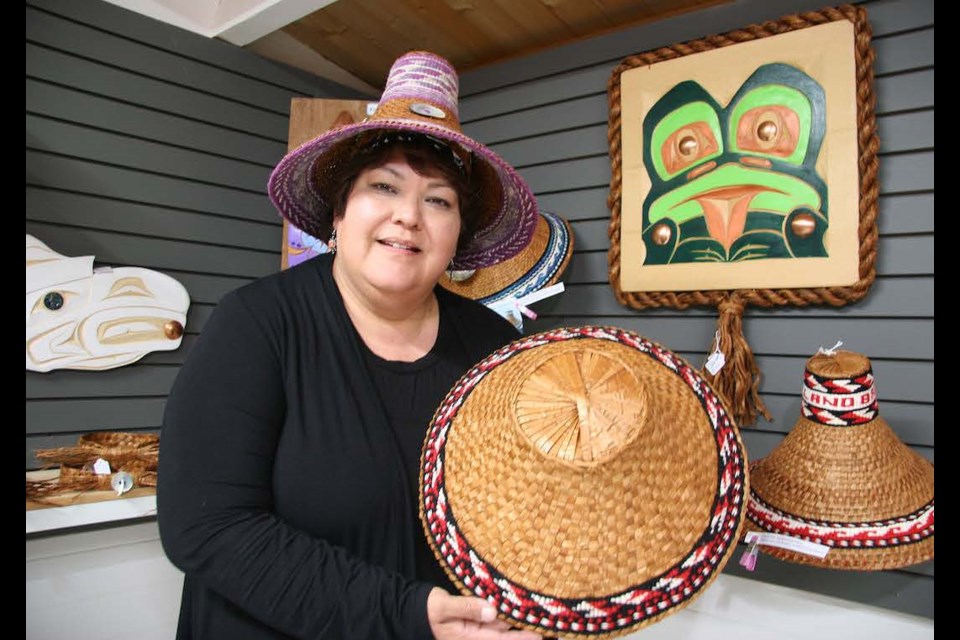With no prompting, proud grandmother Shyanne (“Shy”) Watters, a shíshálh cedar weaver, shares a short cell-phone video of her granddaughter River, age five. The focused youngster deftly braids two long strips of red cedar in a process known as “thinning” or preparing cedar for weaving. At age two, River started helping her grandma with this step towards creating one of Shy’s prized woven cedar hats—and has accompanied her into the forest to obtain cedar bark from local trees
Whether it’s a sasquatch-themed hat with a three-dimensional rendition of the creature’s face behind long back hair, or a Missing and Murdered Indigenous Women hat with a red-dress motif, Shy is known for her imaginative, one-of-a-kind hats. The artist, who’s mostly self-taught, says she adds intricate designs that “kick the boundaries” out of traditional shapes. Her work has spawned interest from others, such as influential Nooksack artist Louie Gong, who discovered her woven hat images on social media.
“There’s no [how-to] book to follow,” says the mother of three. “I’ve been told, ‘There’s no one else who does what you do.’” Her designs include children’s cedar hats with regional sports team themes and colours, such as football’s Seattle Seahawks and hockey’s Vancouver Canucks. Each hat, on average, takes several hours or days to make, depending on its size and complexity.
Shy is perhaps best known for her culturally modified graduation cap. The mortarboard of cedar, abalone and a braided, wool tassel includes a pattern that reflects ocean waves, symbolizing how the Salish Sea brings together her two territories, the Coast Salish and the Kwakwaka’wakw (Kwakiutl). At the cap’s base, she weaves traditional designs that draw from the student’s heritage or school.
One of these caps is part of “Generation to Generation,” a permanent exhibit at the American Museum of Natural History in New York City. It’s among contemporary Northwest Coast First Nations cultural works displayed in a new hall that opened there last year.
When the museum first contacted Shy by email in the fall of 2020, she says she thought it was a scam. But after doing some online research, she learned that both she and Gong, whose art focuses on Indigenous and multi-racial identity, were among seven artists invited to include their work in the museum’s exhibit.
In the letter offering to buy and display her cedar graduation hat, the museum’s vice-president of exhibitions, Lauri Halderman, wrote to Shy: “We don’t see graduation caps like these on the East Coast, and they show your skill and innovation as a weaver. They also tie to a story about how many Native high school graduates in parts of the United States aren’t allowed to wear anything to their graduation that makes their Native culture visible—so they seem especially meaningful.”
Shy has said that the East Coast reference hit home for her because her father’s side of the family has roots in Cape Cod, Mass. and she is a direct descendant from pilgrims who arrived at this continent on the Mayflower in 1620.
Shy’s cultural heritage and centuries of traditional Indigenous weavers who came before her, including her maternal great-grandmother, infuse her work with inspiration. Besides her shíshálh roots, Shy has Skwxwú7mesh (Squamish), Tla’amin (previously known as Sliammon of the Coast Salish) and Kwakwaka’wakw ancestry. In her words: “I feel my ancestors with me when I’m weaving. If I get a vision for something, that’s coming from my ancestors.”
The ch’atlich (Sechelt) resident began weaving 24 years ago, when she sought out Skwxwú7mesh knowledge keeper Fran Nahanee, who lent her a hat mold. Fran showed Shy how to culturally modify trees to get cedar bark and how to weave cedar hats.
Shy also weaves head bands, bracelets, roses and earrings out of cedar. The latter include mini hats or “Land Back” designs with black-and- white merino wool.
She fulfills requests for, and ships, orders across North America.
Besides her cedar creations, Shy is in demand as a weaving instructor. She has taught courses at a variety of educational settings and in other Indigenous communities. The day after our interview, she was heading to Simon Fraser University’s downtown campus to teach a combined in-person and Zoom class. During our interview, she received an email from Vancouver’s Bill Reid Gallery, wanting to know what kind of workshop she could offer.
Shy and her husband Derek Georgeson, a cedar carver, own Aupe Studio in Sechelt and are part of the local artists’ purple banner tour. Next spring, both are slated to appear on “Coastal Carvings,” a documentary series on the Aboriginal Peoples Television Network.
The two artists met in July 2011 on the Salish Sea just off Francis Point Peninsula during an annual tribal canoe journey. They paddled to Swinomish,Wash. as part of a trans-national Indigenous voyage that brings together nations of the Pacific Northwest.




